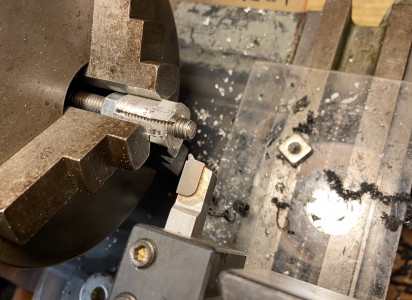Ive been turning 1/4" of thread off the end of some stainless 5/16 bolts so I made a coupling to hold them in my 3 jaw chuck by tapping a piece of 1" long hex alum, slicing it on band saw, chucked it up and all worked fine. After turning a handful I got bugged that I had to overtighten the chuck to prevent the hex from slipping back in the chuck when I pressed a bit with manual feed (I'm coming straight down the ways at the threads perpendicular, like I was reducing the OD.) I decided to turn the hex edges off about 2/3rds of the coupling to leave a shoulder to grab the front of the jaws and stop any slip back. Nice I thought just as Murphy came in and sat down.
Take my first cut on the new improved method and the stud turns in the coupling and advances into the tool bit! Goodbye carbide tool bit. So I put a 5/16 nut on the back of the "hex" thinking that would lock it . Nope, bye bye 2nd carbide tool bit.
So I said F it and ordered a brass coupling nut and a couple new tool bits from McMaster. Two questions
1. why did the thread unspool after I turned the hex off the back half? can't figure that out.
2. On the coupling coming tomorrow -better to put two hex nuts behind it. or once again bisect the coupling ?
Take my first cut on the new improved method and the stud turns in the coupling and advances into the tool bit! Goodbye carbide tool bit. So I put a 5/16 nut on the back of the "hex" thinking that would lock it . Nope, bye bye 2nd carbide tool bit.
So I said F it and ordered a brass coupling nut and a couple new tool bits from McMaster. Two questions
1. why did the thread unspool after I turned the hex off the back half? can't figure that out.
2. On the coupling coming tomorrow -better to put two hex nuts behind it. or once again bisect the coupling ?
Last edited:


